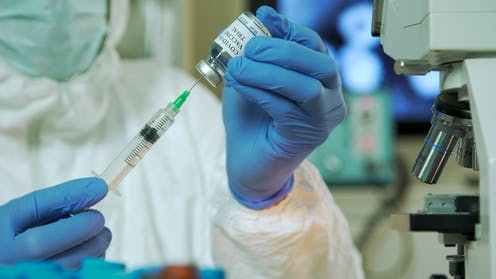Nigeria is one of 92 countries that will receive the free Oxford/Astrazeneca vaccines through COVAX.
Nigeria will on Tuesday receive the first batch of the Oxford/AstraZeneca vaccines through COVAX, the global sharing programme designed to make vaccine access more equal.
Because it is cheap – costs less than two bottles of beer – easy to make and store, AstraZeneca is regarded the most suitable for developing countries like Nigeria.
According to Faisal Shuaib, the executive director of the NPHCDA, the agency at centre of the vaccine rollout plan for Nigeria, approximately 4 million doses will land in Abuja, Nigeria’s capital Tuesday at 11 a.m. making the west African nation the third country to receive jabs from COVAX.
Ghana was the first country to benefit from the programme after receiving 600,000 doses of the AstraZeneca vaccines last Wednesday followed by Ivory Coast that took delivery of over 500, 000 doses last Friday.
At least 92 low and middle-income countries will receive free vaccines through COVAX, a WHO vaccine-sharing initiative.
With the arrival of the 4 million doses, Nigeria is currently the biggest benefactor of the initiative in the first phase. The West African nation is expecting a total 16 million jabs that will come in four phases.
The facility promised access to vaccines for up to 20 per cent of participating countries’ population with an initial supply beginning in the first quarter of the year to immunise three per cent of their populations.
With several concerns raised about the Oxford/AstraZeneca vaccine, here are nine things you should know about.
1. What is the origin?
The vaccine was developed by British firm AstraZeneca, working in partnership with Oxford University. It is however manufactured under license by the Serum Institute in India.
The jab was the second to be approved by the independent Medicines and Healthcare Products Regulatory Agency (MHRA).
AstraZeneca said it expects to be able to manufacture about three billion doses of its vaccine worldwide in 2021.
The vaccine is “virus-vectored”, meaning it is a version of a virus that normally infects chimpanzees and has been modified with a portion of the COVID-19 coronavirus called the “spike protein” to fire the immune system.
Once in human cells, the vaccine should help stimulate the production of antibodies that will resist COVID-19.
2. Why was it rejected by South Africa?
South Africa had initially ordered about 1.5 million doses of Oxford/AstraZeneca vaccine but they were rejected after it was said to provide insufficient protection against the new COVID-19 variant in country, 501Y.V2, according to local health platform, Bhekisisa.
The AstraZeneca jab only provides about 10 per cent protection against mild to moderate COVID-19 disease caused the South African variant, the Bhekisisa reported. This is way below the World Health Organisation (WHO) recommended 50 per cent protection.
This added to the safety concerns raised about the Oxford vaccines.
“South Africa discovered that these vaccines had some weaknesses in protecting their own variant which is quite peculiar,” Nigeria’s health minister, Osagie Ehanire said last week.
“Now we turn to WHO and asked, what do we do? They said well, if you don’t have the South African variant you can use it”, the official explained. “We don’t have that variant meaning we can use it”, he said.
The vaccine is “safe and effective”, according to data published by the Lancet medical journal on December 8. Only one of the 23,754 volunteers who participated in the trials experienced “possibly-related severe side effects”.
3. Can it protect against other variants?
The new variant detected in the UK in September and dubbed “lineage B.1.1.7” has also been found in Nigeria.
It was identified by scientists at the Africa Centre of Excellence for Genomics of Infectious Diseases (ACEGID) in Osun state in August and September when the first two samples were collected.
Nigeria has now confirmed at least 30 cases of the B.1.1.7 variant raising concerns on whether the AstraZeneca vaccines would be efficacious against it.
As viruses mutate and give rise to new variants, this can affect how well certain vaccines work against them.
The AstraZeneca vaccine proved effective against mild to moderate cases from the so-called U.K. variant, according to early data from researchers at the University of Oxford writing in a pre-print not yet reviewed by The Lancet.
Vaccine efficacy was 74.9 per cent (95 per cent CI 41.6-88.9) after two doses against symptomatic infection from the B.1.1.7 variant, the phase II/III trials of research showed.
Interestingly, both the UK and South African variants have the same mutation — the N501Y mutation — but the south African variant has an additional mutation, E484K.
Research shows this mutation contributes to the virus evading antibodies from COVID-19 patients against SARS-CoV-2.
4. Can it protect against infection transmission?
Emerging data for the AstraZeneca vaccine in the Lancet preprint revealed that the jab is most likely to block transmission after a single dose.
The researchers derived this data by taking weekly nose swabs from both symptomatic and asymptomatic cases and testing for the presence of the virus. They observed a 67% fall in swabs positive for the virus after one immunisation.
In a separate preprint, people who received the AstraZeneca vaccine and were swab positive showed reduced periods of viral shedding, which could also have a positive impact on transmission of disease.
This data suggests the AstraZeneca vaccine also has potential to substantially affect virus transmission, by reducing the number of highly infectious people in a population.
5. How cheap is it?
The Oxford-AstraZeneca vaccine has the major advantages of being inexpensive, costing about £2.50 per dose, according to AFP.
This makes it ideal for large-scale vaccination programmes hence the reason it was COVAX choice.
6. How can it be stored and distributed?
One key characteristic of this vaccine is that it can be kept at normal refrigerator temperatures of between two and eight degrees Celsius making it the most suitable for developing country such as Nigeria.
By contrast, the Moderna vaccine needs to be stored at -20C, while the Pfizer/BioNTech product must be kept at -70C and needs ultra-modern freezers which is very costly and high in demand.
The AstraZeneca vaccine can be widely distributed with relative ease.
Additionally, AstraZeneca has multiple supply chains. Around the world, they have multiple manufacturing sites and partners from whom to source ingredients, and distributors who can deploy the vaccine.
7. Timing of doses
Will a person be protected already after one immunisation, while waiting for the second boosting jab?
The Lancelot preprint study showed the vaccine has 76 per cent efficacy after a single dose, when assessed over the first 90 days after vaccination.
In initial studies, the vaccine’s efficacy was 62 per cent with two standard doses. However, there was some variability depending on the dosage and timing.
Since then, scientists have asked questions about the optimal dose and interval. A preprint manuscript in The Lancet shows the vaccine demonstrated 82.4 per cent efficacy after two standard doses three months apart.
8. Is it safe for people that are 65 and above?
Another major concern scientists are raising about AstraZeneca is on how safe the vaccines are on older people.
Researchers in the United States have noted that the preliminary results from the most promising trial of the vaccines are not clear and did not reflect data from older people, the NewYork Times reported.
Also, Germany’s Handelsblatt Newspaper reported that the vaccines were largely ineffective in people aged over 65 although AstraZeneca top managers described the report as “completely incorrect”.
Official data published days later would help undermine the report – attributed to German officials and further exposing the brewing political conflict between the vaccine makers and some European countries, according to Financial Times.
In the Phase 2 human trials, the vaccine was found to be safe, showing just some mild and moderate reactions, and it induced similar immune responses across age groups.
9. Any other side effect?
There was a key mistake in the vaccine dosage received by some study participants, adding to questions about whether the vaccine’s apparently spectacular efficacy will hold up under additional testing, the NewYork Times reported.
Scientists and industry experts said the error and a series of other irregularities and omissions in the way AstraZeneca initially disclosed the data have eroded their confidence in the reliability of the results.
The British laboratory announced in interim findings in November that its vaccine was on average 70 per cent effective, compared with more than 90 per cent for Pfizer/BioNTech and Moderna.
The efficacy of the Oxford-AstraZeneca vaccine was 90 per cent for volunteers who first received only a half-dose and then a full dose one month later, but only 62% for another group that was vaccinated with two full doses one month apart.
The injection of a half-dose was conducted by accident, raising criticism over the robustness of the results and prompting the company to announce on November 26 that an “additional study” would be held into the efficacy of the reduced dosage.
PREMIUM TIMES






